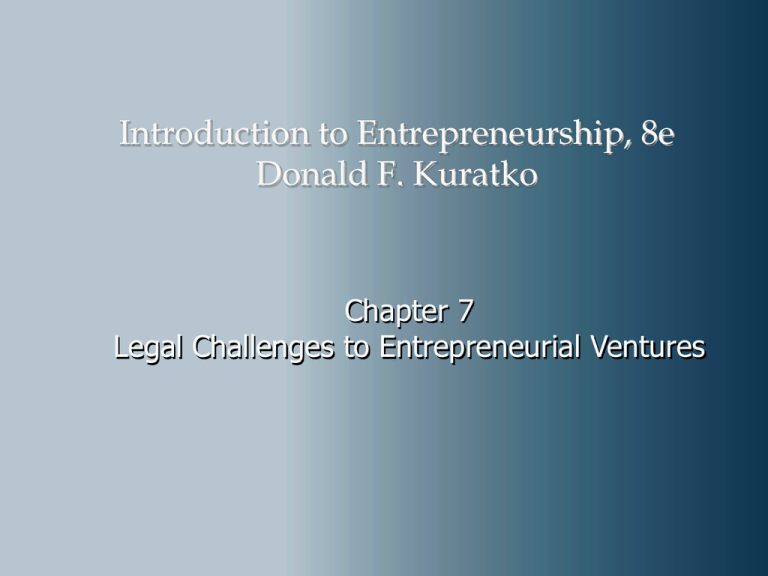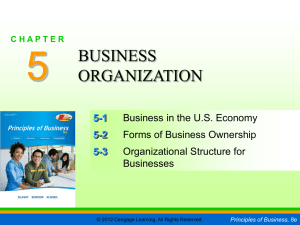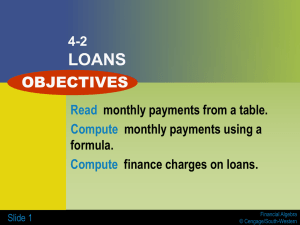
Introduction to Entrepreneurship, 8e
Donald F. Kuratko
Chapter 7
Legal Challenges to Entrepreneurial Ventures
Chapter Objectives
1. To introduce the importance of legal issues to
entrepreneurs
2. To examine patent protection, including definitions
and preparation
3. To review copyrights and their relevance to
entrepreneurs
4. To study trademarks and their impact on new ventures
5. To examine the legal forms of organization—sole
proprietorship, partnership, and corporation
6. To illustrate the advantages and disadvantages of each
of these three legal forms
© 2009 South-Western, a part of Cengage Learning. All rights reserved.
7–2
Chapter Objectives (cont’d)
7. To explain the nature of the limited partnership and
limited liability partnerships (LLPs)
8. To examine how an S corporation works
9. To define the additional classifications of corporations,
including limited liability companies (LLCs)
10. To present the major segments of the bankruptcy law
that apply to entrepreneurs
© 2009 South-Western, a part of Cengage Learning. All rights reserved.
7–3
Legal Challenges for
the Entrepreneurial Venture
Inception of the
Venture
The Ongoing
Venture
Legal
Concepts
Growth and
Continuity of the
Venture
© 2009 South-Western, a part of Cengage Learning. All rights reserved.
7–4
Major Legal Concepts and Entrepreneurial Ventures
• I. Inception of an Entrepreneurial Venture
A. Laws governing intellectual property
• 1. Patents
• 2. Copyrights
• 3. Trademarks
B. Forms of business organization
•
•
•
•
1. Sole proprietorship
2. Partnership
3. Corporation
4. Franchise
C. Tax considerations
D. Capital formation
E. Liability questions
© 2009 South-Western, a part of Cengage Learning. All rights reserved.
7–5
Major Legal Concepts and Entrepreneurial Ventures
• II. Ongoing Venture: Business Development and
Transactions
A. Personnel Law
• 1. Hiring and firing policies
• 2. Equal Employment Opportunity Commission
• 3. Collective bargaining
B. Contract Law
• 1. Legal contracts
• 2. Sales contracts
• 3. Leases
© 2009 South-Western, a part of Cengage Learning. All rights reserved.
7–6
Major Legal Concepts and Entrepreneurial Ventures
• III. Growth and Continuity of an Entrepreneurial Venture
A. Tax considerations
• 1. Federal, state, and local
• 2. Payroll
• 3. Incentives
B. Governmental regulations
• 1. Zoning (property)
• 2. Administrative agencies (regulatory)
• 3. Consumer law
C. Continuity of ownership rights
• 1. Property laws and ownership
• 2. Wills, trusts, and ownership
• 3. Bankruptcy
© 2009 South-Western, a part of Cengage Learning. All rights reserved.
7–7
Intellectual Property Protection: Patents
• Patent
Provides the owner with exclusive rights to hold,
transfer, and license the production and sale of the
product or process as an intellectual property right.
Design patents last for 14 years; all others last for 20
years.
• What Items Qualify for Patent Protection?
Processes, machines, products, plants, compositions
of elements (chemical compounds), and
improvements on already existing items.
© 2009 South-Western, a part of Cengage Learning. All rights reserved.
7–8
Securing a Patent
• Rule 1: Pursue patents that are broad, are
commercially significant, and offer a
strong position.
• Rule 2: Prepare a patent plan in detail.
• Rule 3: Have your actions relate to your original
patent plan.
• Rule 4: Establish an infringement budget.
• Rule 5: Evaluate the patent plan strategically.
© 2009 South-Western, a part of Cengage Learning. All rights reserved.
7–9
Intellectual Property Protection: Patents
•
Patent Application
1. Specification: the text of a patent and may include
any accompanying illustrations.
a. An introduction explaining why the invention will be useful.
b. A description of prior art considered similar to the invention.
c. A summary of the essence of the technology/invention, its
differences from prior art and requisite features.
d. A description of the invention, including anything remotely
relevant, reference to variations, and number bounds.
e. Examples and/or experimental results, in full detail.
2. Claims: a series of short paragraphs, each of which
identifies a particular feature or combination of
features that is protected by the patent.
© 2009 South-Western, a part of Cengage Learning. All rights reserved.
7–10
Figure
7.1
The Patent Process: From Application to Allowance and Issue
Continued on following slide
Source: United States Patent Office, 2005.
© 2009 South-Western, a part of Cengage Learning. All rights reserved.
7–11
Figure
7.1
The Patent Process: From Application to Allowance and Issue
(cont’d)
Continued on following slide
Source: United States Patent Office, 2005.
© 2009 South-Western, a part of Cengage Learning. All rights reserved.
7–12
Figure
7.1
The Patent Process: From Application to Allowance and Issue
(cont’d)
Source: United States Patent Office, 2005.
© 2009 South-Western, a part of Cengage Learning. All rights reserved.
7–13
Intellectual Property Protection: Copyrights
• Copyright
Provides exclusive rights to creative individuals for the
protection of their literary or artistic productions.
Duration: life of the author plus 70 years.
• The copyright owner has the rights to:
Reproduce the work
Prepare derivative works based on it
Distribute copies of the work by sale or otherwise
Perform the work publicly
Display the work publicly
Sell or transfer individual rights
© 2009 South-Western, a part of Cengage Learning. All rights reserved.
7–14
Intellectual Property Protection: Copyrights
• Copyright Protection
The material must be in a tangible form so it can be
communicated or reproduced.
It also must be the author’s own work and thus the
product of his or her skill or judgment.
Formal registration of a copyright is with the Copyright
Office of the Library of Congress.
© 2009 South-Western, a part of Cengage Learning. All rights reserved.
7–15
Copyrights (cont’d)
• Fair Use Doctrine
Reproduction of a copyright work for purposes such
as criticism, comment, news reporting, teaching
(including multiple copies for classroom use),
scholarship, or research is not an infringement of
copyright.
• Protected Ideas?
The Copyright Act specifically excludes copyright
protection for any “idea, procedure, process, system,
method of operation, concept, principle, or discovery,
regardless of the form in which it is described,
explained, illustrated, or embodied.”
© 2009 South-Western, a part of Cengage Learning. All rights reserved.
7–16
Intellectual Property Protection: Trademarks
• Trademark
A distinctive name, mark, symbol, or motto identified
with a company’s product(s) and registered at the
Patent and Trademark Office
• Advantages of Trademark Registration
Nationwide constructive notice of the owner’s right to
use the mark
Bureau of Customs protection against importers using
the mark
Incontestability of the mark after five years
© 2009 South-Western, a part of Cengage Learning. All rights reserved.
7–17
Intellectual Property Protection: Trademarks
• Trademark Duration
Current registrations are good for 10 years with the
possibility for continuous renewal every 10 years.
A trademark may be invalidated in four specific ways:
• Cancellation proceedings
• Cleaning-out procedure
• Abandonment
• Generic meaning
© 2009 South-Western, a part of Cengage Learning. All rights reserved.
7–18
Trademarks (cont’d)
• Avoiding the Trademark Pitfalls
Rule 1: Never select a corporate name or a mark without first
doing a trademark search.
Rule 2: If your attorney says you have a potential problem with a
mark, trust his or her judgment.
Rule 3: Seek a coined or a fanciful name or mark before you
settle for a descriptive or a highly suggestive one.
Rule 4: Whenever marketing or other considerations dictate the
use of a name or a mark that is highly suggestive of the
product, select a distinctive logotype for the descriptive or
suggestive words.
Rule 5: Avoid abbreviations and acronyms wherever possible,
and when no alternative is acceptable, select a distinctive
logotype in which the abbreviation or acronym appears.
© 2009 South-Western, a part of Cengage Learning. All rights reserved.
7–19
Trade Secrets
• Trade Secret
Business processes and information that cannot be
patented, copyrighted, or trademarked but makes an
individual company unique and has value to a
competitor could be a trade secret.
• Information Is Considered a Trade Secret:
If it is not known by the competition.
If the business would lose its advantage if the
competition were to obtain it.
If the owner has taken reasonable steps to protect the
secret from disclosure.
© 2009 South-Western, a part of Cengage Learning. All rights reserved.
7–20
Trade Secrets
• Examples of Trade Secrets:
Customer lists
Strategic plans
Research and development
Pricing information
Marketing techniques
Production techniques
© 2009 South-Western, a part of Cengage Learning. All rights reserved.
7–21
Trademark Protection on the Internet
• Cyberlaw
The emerging body of law governing cyberspace.
• Domain Names (Internet Addresses)
The principles of trademark law apply to domain
names (Cybersquatters).
Unauthorized use of another’s mark in a domain name
may constitute trademark infringement.
© 2009 South-Western, a part of Cengage Learning. All rights reserved.
7–22
Identifying Legal Structures
• A legal structure that will best suits the demands
of the venture addresses:
Changing tax laws
Liability situations
The availability of capital
The complexity of business formation.
• Three primary legal forms of organization
Sole proprietorship
Partnership
Corporation
© 2009 South-Western, a part of Cengage Learning. All rights reserved.
7–23
Sole Proprietorships
• Sole Proprietorship
A business that is owned and operated by one person.
The enterprise has no existence apart from its owner.
To establish a sole proprietorship, a person merely
needs to obtain whatever local and state licenses are
necessary to begin operations.
© 2009 South-Western, a part of Cengage Learning. All rights reserved.
7–24
Sole Proprietorships (cont’d)
•Advantages
Ease
Sole
of formation
ownership of profits
Decision
making and
control vested in one
owner
Flexibility
Relative
freedom from
governmental control
Freedom
from corporate
business taxes
© 2009 South-Western, a part of Cengage Learning. All rights reserved.
•Disadvantages
Unlimited
liability
Lack
of continuity
Less
available capital
Relative
difficulty
obtaining long-term
financing
Relatively
limited
viewpoint and
experience
7–25
Partnerships
• Partnership
An association of two or more persons acting as coowners of a business for profit.
The Revised Uniform Partnership Act (RUPA) acts the
guide for legal requirements in forming partnerships.
• Articles of Partnership
Clearly outline the financial and managerial
contributions of the partners and carefully delineate
the roles in the partnership relationship.
© 2009 South-Western, a part of Cengage Learning. All rights reserved.
7–26
Articles of Partnership Items
• Name, purpose, domicile
• Separate debts
• Duration of agreement
• Authority (individual partner’s
• Character of partners (general or
limited, active or silent)
• Contributions by partners (at
inception, at later date)
authority on business conduct)
• Books, records, and method of
accounting
• Sale of partnership interest
• Division of profits and losses
• Arbitration
• Draws or salaries
• Settlement of disputes
• Rights of continuing partner(s)
• Additions, alterations, or
• Death of a partner (dissolution and
windup)
modifications of partnership
• Required and prohibited acts
• Release of debts
• Absence and disability
• Business expenses (method of
• Employee management
handling)
© 2009 South-Western, a part of Cengage Learning. All rights reserved.
7–27
Partnerships (cont’d)
• Advantages
Ease of formation
Direct rewards
Growth and
performance facilitated
• Disadvantages
Unlimited liability of at
least one partner
Lack of continuity
Relative difficulty
obtaining large sums of
capital
Flexibility
Relative freedom from
governmental control
and regulation
Bound by the acts of
just one partner
Possible tax advantage
Difficulty of disposing
of partnership interest
© 2009 South-Western, a part of Cengage Learning. All rights reserved.
7–28
Corporations
• Corporation
“An artificial being, invisible, intangible, and existing
only in contemplation of the law”.
–Supreme Court Justice John Marshall
As such, a corporation is a separate legal entity apart
from the individuals who own it.
• Forming a Corporation
Subscriptions for capital stock must be taken and a
tentative organization created.
Approval (a charter) must be obtained from the
secretary of state in the state in which the corporation
is to be formed.
© 2009 South-Western, a part of Cengage Learning. All rights reserved.
7–29
Corporations (cont’d)
• Advantages
• Disadvantages
Limited liability
Activity restrictions
Transfer of ownership
Lack of representation
Unlimited life
Regulation
Relative ease of
securing capital in
large amounts
Organizing expenses
Double taxation
Increased ability and
expertise
© 2009 South-Western, a part of Cengage Learning. All rights reserved.
7–30
Table
7.3
Sole
Proprietorship
General Characteristics of Forms of Business
Partnership
Limited Liability
Partnership
Limited
Partnership
Limited Liability
Limited
Partnership
Corporation
S Corporation
Limited Liability
Company
Formation
When one
person owns a
business
without
forming a
corporation or
LLC
By agreement of
owners or by
default when two
or more owners
conduct business
together without
forming a limited
partnership, an
LLC or a
corporation
By agreement of
owners; must
comply with
limited liability
partnership
statute
By agreement of
owners; must
comply with
limited
partnership
statute
By agreement of
owners; must
comply with
limited liability
limited
partnership
statute
By agreement of
owners; must
comply with
corporation
statute
By agreement of
owners; must
comply with
corporation state;
must elect S
Corporation
status under
Subchapter S of
Internal Revenue
Code
By agreement of
owners; must
comply with
limited liability
company statute
Duration
Terminates on
death or
withdrawal of
sole proprietor
Usually
unaffected by
death or
withdrawal of
partner
Unaffected by
death or
withdrawal of
partner
Unaffected by
death or
withdrawal of
partner, unless
sole general
partner
dissociates
Unaffected by
death or
withdrawal of
partner, unless
sole general
partner
dissociates
Unaffected by
death or
withdrawal of
shareholder
Unaffected by
death or
withdrawal of
shareholder
Usually
unaffected by
death or
withdrawal of
member
Management
By sole
proprietor
By partners
By partners
By general
partners
By general
partners
By board of
directors
By board of
directors
By managers or
members
Owner Liability
Unlimited
Unlimited
Mostly limited to
capital
contribution
Unlimited for
general partners;
limited to capital
contribution for
limited partners
Limited to capital
contribution
Limited to capital
contribution
Limited to capital
contribution
Limited to capital
contribution
Transferability
of Owners’
Interest
None
None
None
None, unless
agreed otherwise
None, unless
agreed otherwise
Freely
transferable,
although
shareholders may
agree otherwise
Freely
transferable,
although
shareholders
usually agree
otherwise
None, unless
agreed otherwise
Source: Jane P. Mallor, A. James Barnes, Thomas Bowers, and Arlen W. Langvardt, Business Law:
The Ethical, Global, and E-Commerce Environment, 13 ed., McGraw Hill Irwin, 2007, p. 897.
© 2009 South-Western, a part of Cengage Learning. All rights reserved.
7–31
Table
7.3
Sole
Proprietorship
Federal
Income
Taxation
Only sole
proprietor
taxed
General Characteristics of Forms of Business
Partnership
Only partners
taxed
Limited Liability
Partnership
Usually only
partners taxed;
may elect to be
taxed like a
corporation
Limited
Partnership
Usually only
partners taxed;
may elect to be
taxed like a
corporation
Limited Liability
Limited
Partnership
Usually only
partners taxed;
may elect to be
taxed like a
corporation
Source: Jane P. Mallor, A. James Barnes, Thomas Bowers, and Arlen W. Langvardt, Business Law:
The Ethical, Global, and E-Commerce Environment, 13 ed., McGraw Hill Irwin, 2007, p. 897.
© 2009 South-Western, a part of Cengage Learning. All rights reserved.
Corporation
Corporation
taxed;
shareholders
taxed on
dividends (double
tax)
S Corporation
Limited Liability
Company
Only shareholders Usually only
taxed
members taxed;
may elect to be
taxed like a
corporation
7–32
Specific Forms of Partnerships and
Corporations (cont’d)
• S Corporation
Takes its name from Subchapter S of the Internal
Revenue Code.
Is commonly known as a “tax option corporation”—it is
taxed similarly to a partnership.
Avoids the imposition of income taxes at the corporate
level yet retain the benefits of a corporate form
(especially the limited liability).
© 2009 South-Western, a part of Cengage Learning. All rights reserved.
7–33
Guidelines for S Corporations
• The corporation must be a domestic corporation.
• The corporation must not be a member of an affiliated
group of corporations.
• The shareholders of the corporation must be individuals,
estates, or certain trusts.
• Corporations, partnerships, and nonqualifying trusts
cannot be shareholders.
• The corporation must have 100 or fewer shareholders.
• Only one class of stock, although not all shareholders
may have the same voting rights.
• No shareholder may be a nonresident alien.
© 2009 South-Western, a part of Cengage Learning. All rights reserved.
7–34
Specific Forms of Partnerships and
Corporations
• Limited Partnerships
Have two or more partners without responsibility for
management and without liability for losses beyond
their investment with the right to share in the profits.
• Formed under The Uniform Limited Partnership Act (ULPA).
• Limited Liability Partnership (LLP)
Allows professionals the tax benefits of a partnership
while avoiding personal liability for the malpractice of
other partners.
© 2009 South-Western, a part of Cengage Learning. All rights reserved.
7–35
Specific Forms of Partnerships and
Corporations (cont’d)
• Limited Liability Limited Partnership (LLLP)
has elected limited liability status for all of its partners,
including general partners.
• Limited Liability Company (LLC)
A hybrid form of business enterprise that offers the
limited liability of a corporation but the tax advantages
of a partnership.
Disadvantage is that LLC statutes differ from state to
state, and thus any firm engaged in multi-state
operations may face difficulties.
© 2009 South-Western, a part of Cengage Learning. All rights reserved.
7–36
Table
7.4
Principal Characteristics of Limited Partnerships and LLLPs
1.
A limited partnership or LLLP may be created only in accordance with a statute.
2.
A limited partnership or LLLP has two types of partners: general partners and limited partners.
It must have one or more of each type.
3.
All partners, limited and general, share the profits of the business.
4.
Each limited partner has liability limited to his capital contribution to the business. Each
general partner of a limited partnership has unlimited liability for the obligations of the
business. A general partner in an LLLP, however, has liability limited to his capital
contribution.
5.
Each general partner has a right to manage the business, and she is an agent of the limited
partnership or LLLP. A limited partner has no right to manage the business or to act as its
agent, but he does have the right to vote on fundamental matters. A limited partner they
manage the business, yet retain limited liability for partnership obligations.
6.
General partners, as agents, are fiduciaries of the business. Limited partners are not
fiduciaries.
7.
A partner’s rights in a limited partnership or LLLP are not freely transferable. A transferee of a
general or limited partnership interest in not a partner, but is entitled only to the transferring
partner’s share of capital and profits.
8.
The death or other withdrawal of a partner does not dissolve a limited partnership or LLLP,
unless there is no surviving general partner.
9.
Usually, a limited partnership or LLLP is taxed like a partnership.
Source: Jane P. Mallor, A. James Barnes, Thomas Bowers, and Arlen W. Langvardt, Business Law:
The Ethical, Global, and E-Commerce Environment, 13 ed., McGraw Hill Irwin, 2007, p. 953.
© 2009 South-Western, a part of Cengage Learning. All rights reserved.
7–37
Understanding Bankruptcy
• Bankruptcy
When
a venture’s financial obligations are greater than
its assets and it is unable to meet its obligations.
• The Bankruptcy Act
A federal
law that provides for specific procedures for
handling insolvent debtors—those who are unable to
pay debts as they become due.
• Ensures that the property of the debtor is distributed fairly to
the creditors.
• Protects creditors from having debtors unreasonably diminish
their assets.
• Protects debtors from extreme demands by creditors.
© 2009 South-Western, a part of Cengage Learning. All rights reserved.
7–38
Bankruptcy (cont’d)
• Chapter 7: Straight Bankruptcy
Sometimes
referred to as “liquidation.”
Requires
the debtor to surrender all property to a
trustee appointed by the court.
• Chapter 11: Reorganization
The
most common form of bankruptcy.
Under
this format, a debtor attempts to formulate a
plan to pay a portion of the debts, have the remaining
sum discharged, and continue to stay in operation.
© 2009 South-Western, a part of Cengage Learning. All rights reserved.
7–39
Bankruptcy (cont’d)
• Chapter 13: Adjustment of Debts
Individuals or sole proprietors with unsecured debts of
less than $100,000 or secured debts of less than
$350,000 are eligible to file under a Chapter 13
procedure.
In the petition the debtor declares an inability to pay
his or her debts and requests some form of extension
through future earnings (a longer period of time to
pay) or a composition of debt (a reduction in the
amount owed).
© 2009 South-Western, a part of Cengage Learning. All rights reserved.
7–40
Table
7.5
Bankruptcy: A Comparison of Chapters 7, 11, and 13
Chapter 7
Chapter 11
Chapter 13
PURPOSE
Liquidation
Reorganization
Adjustment
WHO CAN
PETITION
Debtor (voluntary) or creditors
(involuntary)
Debtor (voluntary) or creditors
(involuntary)
Debtor (voluntary) only
WHO CAN BE
A DEBTOR
Any “person” (including
partnerships and corporations)
except railroads, insurance
companies, banks, savings and
loan institutions, and credit
unions. Farmers and charitable
institutions cannot be
involuntarily petitioned.
Any debtor eligible for Chapter 7
relief; railroads are also eligible.
Any individual (not partnerships
or corporations) with regular
income who owes fixed
unsecured debt of less than
$290,525 or secured debt of less
than $871,550.
PROCEDURE
LEADING TO
DISCHARGE
Nonexempt property is sold with
proceeds to be distributed (in
order) to priority groups.
Dischargeable debts are
terminated.
A plan is submitted and, if it is
approved and followed, debts
are discharged.
A plan is submitted (must be
approved if debtor turns over
disposable income for three year
period) and, if it is approved and
followed, debts are discharged.
ADVANTAGES
On liquidation and distribution,
most debts are discharged, and
the debtor has an opportunity for
a fresh start.
The debtor continues in
business. Creditors can accept
the plan, or it can be “crammed
down” on them. The plan allows
for a reorganization and
liquidation of debts over the plan
period.
The debtor continues in
business or keeps possession of
assets. If the plan is approved,
most debts are discharged after
a three year period.
Source: Roger LeRoy Miller and Gaylord A. Jentz, Fundamentals of Business Law, 6th ed. (Mason, OH: SouthWestern, a division of Thomson Learning: http://www.thomsonrights.com, © 2005), 438. Reprinted with permission.
© 2009 South-Western, a part of Cengage Learning. All rights reserved.
7–41
Keeping Legal Expenses Down
• Establish the fee structure with an attorney beforehand.
• Establish clear written agreements on all critical matters that affect
business operations.
• Always attempt to settle any dispute rather than litigate.
• Have your attorney share forms in electronic format.
• Use a less expensive attorney for small collections.
• Suggest cost-savings to your attorney for business matters.
• Always check with your attorney during normal business hours.
• Consult with your lawyer on several matters at one time.
• Keep abreast of legal developments in your field.
• Handle some matters yourself.
• Involve attorneys early when it is feasible
© 2009 South-Western, a part of Cengage Learning. All rights reserved.
7–42
Key Terms and Concepts
• abandonment
• limited liability partnership (LLP)
• bankruptcy
• limited partnership
• Bankruptcy Act
• liquidation
• cancellation proceedings
• partnership
• claims
• patent
• cleaning-out procedure
• Patent and Trademark Office
• copyright
• Revised Uniform Limited
• corporation
• debtor-in-possession
•
• fair use doctrine
•
• generic meaning
•
• infringement budget
•
• intellectual property right
•
• limited liability company (LLC)
•
Partnership Act (RULPA)
S corporation
sole proprietorship
specification
trademark
trade secrets
unlimited liability
• limited liability limited partnership
(LLLP)
© 2009 South-Western, a part of Cengage Learning. All rights reserved.
7–43









